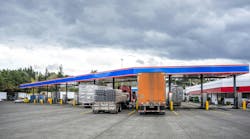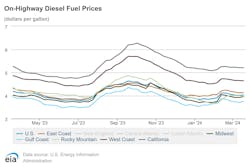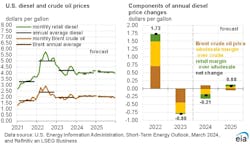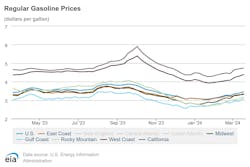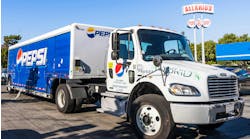The average national on-highway diesel fuel price inched up 2 cents to $4.028 per gallon, according to the U.S. Energy Information Administration, which released its final fuel tracking data Monday before spring officially begins later this week. Gasoline pump price averages saw a bigger jump this week, and the national average now stands higher than it was a year ago.
The March 18 national diesel average was 15 cents less than this time last year, according to EIA. As for the rest of the country, incremental gains and losses in diesel pump prices remained the norm, contributing to a general price plateau that began around Feb. 12.
For the regions that did see a price increase, the East Coast saw its diesel rates rise less than a cent to $4.127, while the New England and Lower Atlantic sub-regions each increased by 1 cent to $4.300 and $4.046, respectively. On the higher end of diesel price increases, Midwest average prices rose 4 cents to $3.955, with the Gulf Coast up a similar amount to $3.745 per gallon.
See also: Diesel to still rule transportation 'for many years'
As for regions that saw their diesel prices fall, the Rocky Mountain region saw a 2-cent decrease to $3.968, followed by the West Coast, including California, which decreased by 1 cent to $4.639. Considering all these changes, the Gulf Coast is still the cheapest place to buy diesel fuel at $3.745 per gallon, while California is still the most expensive at $5.203.
In comparison, AAA Motor Club logged its current diesel average at $4.027 per gallon, nearly identical to the EIA’s current figures. According to AAA, this figure is barely cheaper than last week’s of $4.033 per gallon but still cheaper than last year’s rate of $4.310.
According to the EIA’s Short-Term Energy Outlook, this relative consistency in diesel pricing is similar to how monthly retail diesel and Brent crude oil prices are very close, if not identical to the annual average. The outlook also anticipates that retail diesel costs will dip below the 2024 average before rising again heading into 2025.
Gasoline prices continue to creep upward at $3.453 per gallon
Average gasoline prices have continued to rise throughout the week, with the EIA reporting the current nationwide average at $3.453, a figure up 7 cents from a week ago and 3 cents higher than this time last year. Prices also increased across the country at 2-15 cents, depending on the region.
Prices rose the least in the Midwest, only 2 cents to $3.309 per gallon, followed by the Central Atlantic subregion, which rose 6 cents to $3.309. Meanwhile, the Gulf Coast’s gas costs rose the most, 15 cents to $3.099, finally breaking into prices at or above $3. The West Coast without California saw their gasoline prices increase the most, 15 cents to $3.994 per gallon.
In the final days of winter, the Gulf Coast is still the cheapest place for gasoline at $3.099, while California is the most expensive at $4.734.
The AAA also logged gas prices similar to those of the EIA this week, with their nationwide average at $3.467, 7 cents more than last week and 2 cents more than this time last year. The price rise could be due to increased oil barrel costs, greater gas demand, and more expensive summer blends of fuel, which could push pump prices 10-15 more cents in the coming weeks, the AAA reported in a press release. The EIA agreed in its Short-Term Energy Outlook, stated that they expected a global oil inventory decline for Q2 of 2024 due to OPEC+ crude oil production cuts, which could lead to Brent crude oil spot prices reaching $88 per barrel and average at $87 per barrel this year, all of which could lead to higher fuel prices for consumers.
“This is the time of year we normally see pump prices start to rise,” said Andrew Gross, AAA spokesperson. “And while prices have been rather pokey so far, they should begin to accelerate and move higher very soon.”
